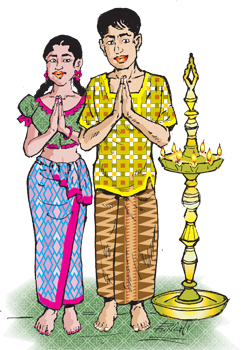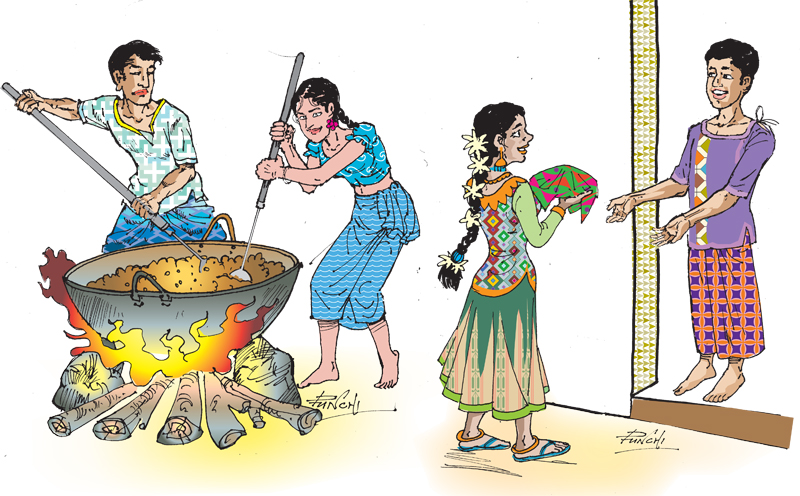
The Sinhala and Tamil New Year is one of the most important and awaited holidays on the Sri Lankan calendar. Referred to as the Aluth Avurudda by the Sinhalese and Puthandu by the Tamil community, this is celebrated in many households as the sun moves from Pisces (commonly referred to as Meena Rashiya) to Aries (commonly referred to as Mesha Rashiya) marking the end of the harvest season. This joyous occasion celebrated during April 13 and 14 is an annual expression of the rich culture of the multi-ethnic island nation. Through the many interesting customs, delicious traditional sweetmeats and food and the fun activities, this time of the year creates an opportunity for all Sri Lankans to unite, offer gratitude and celebrate as one nation.
Sinhalese New Year customs and traditions
Nonagathaya/Punya Kalaya
The time slot between the ending of the Old Year and the dawning of the New Year which is referred as the Nonagathe, Nonagathaya or Punya Kalaya is a neutral time.
According to Sinhalese beliefs, this time is used to observe and perform religious ceremonies. During this time period, people are seen heading to their respective temples clad in white. Buddhist Sri Lankans are also encouraged to refrain from engaging in any of their day-to-day activities and to engage in religious activities and seek blessings from priests or monks.
Welcoming the New Year

As this annual celebration is of utmost importance to most Sri Lankans, preparation for the New Year begins very early. From cleaning and repainting households to buying new clothes for family members and preparing traditional sweetmeats, the New Year duties are endless. The purchase of the new clay pot is also considered to be an important tradition. The traditional milk rice is prepared thereafter and the rest of the traditional sweets such as Kavum, Konda Kavum, Kalu Dodol, Kokis, Mung Kevum, Aluva, Mung Guli, Naaran Kavum, Athirasa, Aasmi, Pani Walalu (Unduwel) and many more are served among the family and then distributed among neighbors as well. This simple gesture symbolises unity amongst all without boundaries or biases.
The auspicious time is also when many adults and children commence their work with the determination to do better and achieve their goals during the New Year. From farmers to school children, many are seen participating in their routine work. Another tradition which has been passed down over centuries in Sri Lanka is paying homage to elders. A sheaf of betel leaves is presented to all elders in the family while the young ones seek their blessings for the future.
In between all these rituals, a special ceremony is held to anoint oil which is usually conducted by the oldest family member, and bathing for the New Year. This is practiced in their respective temples as well where the prelate is seen carrying out the tradition which symbolises good health. Auspicious times are provided in the Palapala Litha where there is also a time to leave for jobs. Many people head towards their home towns during the New Year Holidays and head back to their work places with the hope of doing better in the coming year. Another such tradition carried out is the tradition of visiting relatives, neighbours and kith and kin, usually with delicious New Year’s food and/or gift items.
These are just a few of the customs and traditions carried out by the Sinhala people as a part of their celebrations for the New Year.
Tamil New Year customs and traditions
The Tamil community also celebrate the New Year, commonly known as Puththandu, by observing the traditions and rituals practiced by ancestors over the years. These Tamil traditions are slightly different from the traditions followed by the Sinhala people although the ultimate wish and expectation for the dawning the New Year may be common to everyone.
Homes are cleaned and made ready prior to the occasion. On the day of the dawn of the New Year, during the auspicious time, Maruthu Neer which is clean water boiled with various herbs, selected flowers and leaves, milk, saffron and other ingredients are made by the priests in temples. The Maruthu Neer is then applied on the heads of all family members prior to bathing. New clothes are recommended according to the colours mentioned in the almanac. A sweet rice is made if possible, with new raw red rice, jaggery, cashew nuts, ghee and plums.
 The area in front of the house is cleaned and sprinkled with saffron water, and cow dung. A decorative design Kolam is done with raw white rice flour. The hearth is assembled a little bit away facing the East, and a new pot is used to cook the Pongal. Lamps are lit by the lady of the house and the head of the household arranges the Mangala Kumbam. The Mangala Kumbam is a pot with five mango leaves and a coconut, lit joss sticks, a tray of flowers, betel leaves, arecanuts, a comb of bananas and the sweet rice. This is offered to the Sun God and Lord Ganesh to complete the pooja. A part of tradition is for a coconut to be broken by the head of the household and incense to be burnt. Much like in the Sinhalese culture, the elders in the family then bless the children, who worship them and seek their blessings and good wishes.
The area in front of the house is cleaned and sprinkled with saffron water, and cow dung. A decorative design Kolam is done with raw white rice flour. The hearth is assembled a little bit away facing the East, and a new pot is used to cook the Pongal. Lamps are lit by the lady of the house and the head of the household arranges the Mangala Kumbam. The Mangala Kumbam is a pot with five mango leaves and a coconut, lit joss sticks, a tray of flowers, betel leaves, arecanuts, a comb of bananas and the sweet rice. This is offered to the Sun God and Lord Ganesh to complete the pooja. A part of tradition is for a coconut to be broken by the head of the household and incense to be burnt. Much like in the Sinhalese culture, the elders in the family then bless the children, who worship them and seek their blessings and good wishes.
A visit to the temple is a must. Customarily alms should be offered to the poor. During the auspicious time, the sweet rice is partaken by the family. Later, the head of the family gives money, betel leaves, paddy and flowers referred to as Kai Vishesham in Tamil, to the family members and wishes them good luck.
Moreover, the head of the family performs, Er Mangalam during this time. Being an agrarian community, ploughing becomes the traditional act on New Year’s Day. Likewise, a teacher would start a lesson, a trader starts a new account, a craftsman starts his craft and so on.
Similar to the Sinhalese custom, visiting relatives and entertaining relatives and friends are also important features of the Tamil New Year celebrations.
Aside from all the different customs and traditions carried out as a part of the celebration of the Sinhala and Tamil New Year, there are many games and activities that people of all cultures engage in together and enjoy. The New Year games can be categorised as indoor and outdoor games. Some of the indoor games are, bello (sea shells) and kaju (cashew nuts).
A special characteristic of the indoor games is that most indoor games are played while sitting on the floor and not on chairs. The outdoor games are havari hengima (hiding the wig), chaggudu and kotta pora (pillow-fighting), kathuru oncilla, ankeliya, olinda keliya, eluvan keliya, mevara sellama, raban upatha, buhu keliya, muthi gesilla, rena dela del, muthu keliya, onchili varam and mee sellama.
The significance of the games is that everyone regardless of the age, gets themselves involved in the competitions. Added to that, when these games are played on a village-scale, the entire neighbourhood gets together which enhances the unity and eliminate the misunderstandings of the past, setting the perfect peaceful and united atmosphere for the New Year, amongst the society.

Illustration: Jagath Punchihewa
